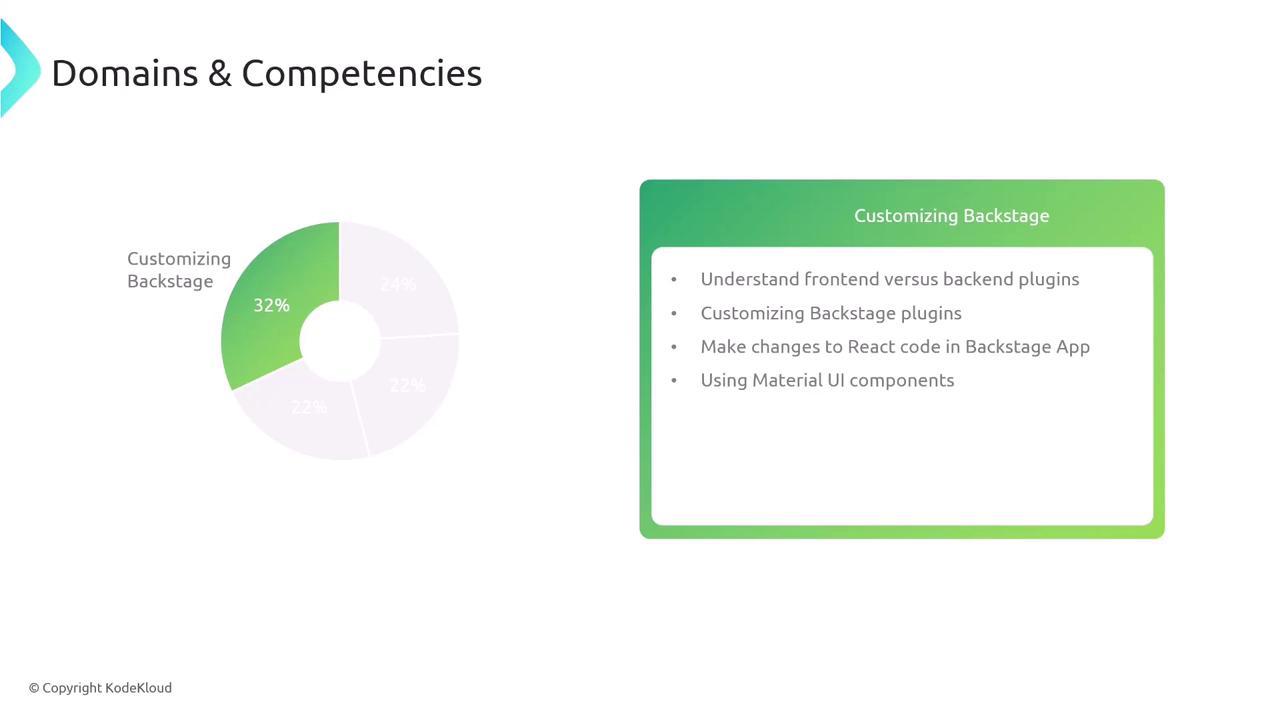Certified Backstage Associate (CBA)
Introduction
Exam Overview
Prepare for success on the Certified Backstage Associate exam by understanding its format, timing, and domain breakdown. This guide covers each exam domain, the percentage weightings, and the key skills you’ll need to demonstrate.
Exam Details
- Proctored online
- 90 minutes, single-answer multiple-choice
- No labs or terminal access required
- Certification valid for two years
Exam Domains and Weightings
| Exam Domain | Weight | Key Topics |
|---|---|---|
| Backstage Development Workflow | 24% | Local build & run, TypeScript compilation, NPM/Yarn, Docker image creation |
| Backstage Infrastructure | 22% | Framework concepts, environment config, production deployment, client-server |
| Backstage Catalog | 22% | Entity registration, annotations, ingestion pipelines, error troubleshooting |
| Customizing Backstage | 32% | Plugin architecture, React customization, Material UI components |
1. Backstage Development Workflow (24%)
In this domain, you’ll demonstrate your ability to set up and iterate on a Backstage app in your local development environment.
- Build and launch a Backstage project locally
- Navigate the Backstage CLI and development server
- Compile code with TypeScript and fix type errors
- Manage dependencies using NPM and Yarn
- Create a Dockerfile and build a container image

2. Backstage Infrastructure (22%)
This section focuses on deploying and configuring Backstage at scale across multiple environments.
- Understand Backstage core architecture and microservices
- Configure
app-config.yamlfor development, staging, and production - Deploy Backstage using Docker, Kubernetes, or serverless platforms
- Secure connections, manage secrets, and enable TLS
- Explain the client-server communication model
3. Backstage Catalog (22%)
Master the Backstage Catalog to inventory and manage your software components.
- Define and register entities in
catalog-info.yaml - Apply annotations for metadata enrichment
- Set up and troubleshoot automated ingestion pipelines
- Manually add entity locations and resolve ingestion errors
- Use the Catalog API for advanced integrations
4. Customizing Backstage (32%)
Extend and tailor Backstage to fit your organization’s needs by creating and modifying plugins.
- Differentiate between front-end and back-end plugins
- Scaffold a new plugin with the Backstage CLI
- Extend existing plugins and contribute code back to the community
- Make React component changes within your Backstage app
- Leverage Material UI to style and enhance user interfaces

Links and References
Watch Video
Watch video content